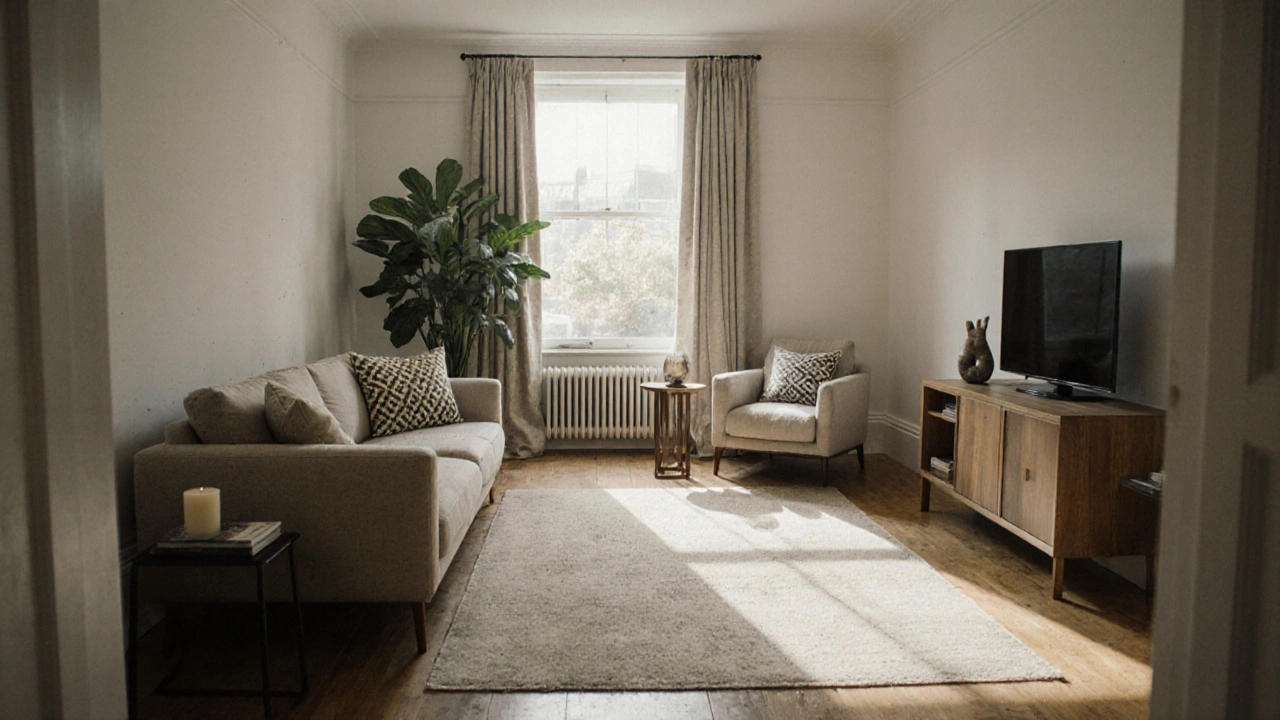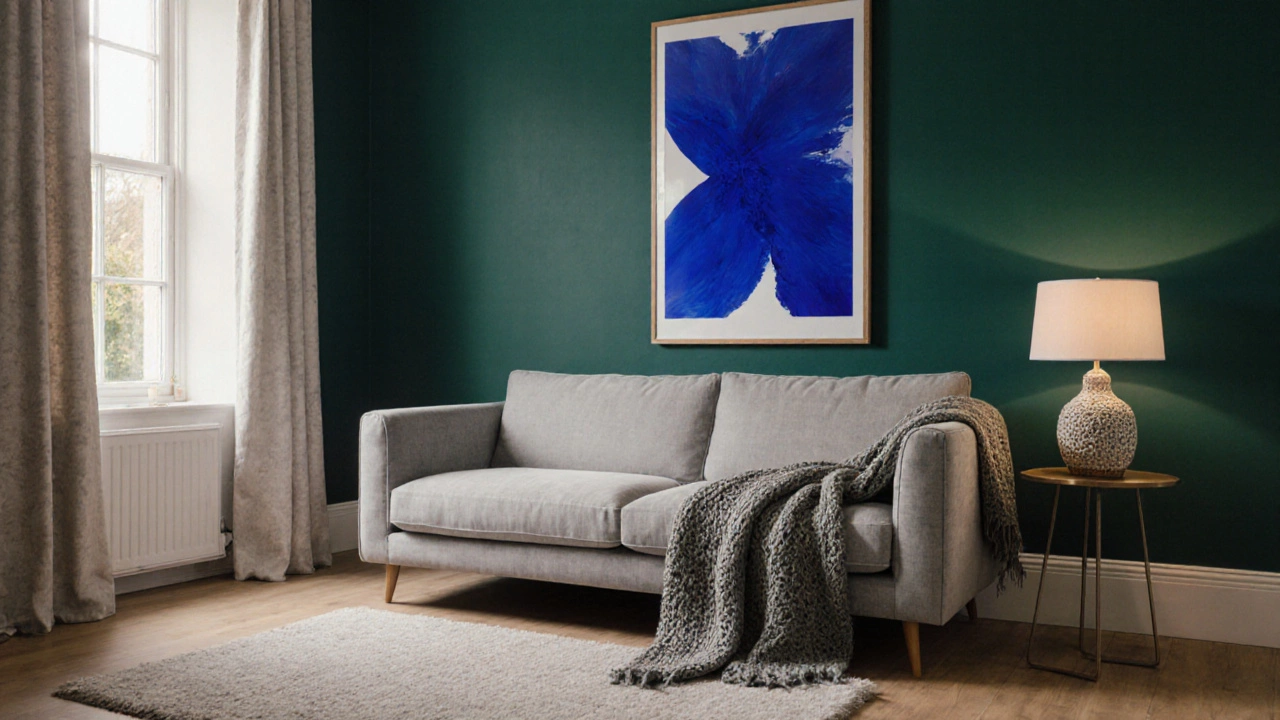Rug Size Calculator
Find the perfect rug size for your living room based on sofa dimensions and room layout. Use the recommended measurements to create visual harmony and make your space feel intentional.
Suggested Rug Size:
This measurement ensures your rug sits under the front legs of your sofa and chairs while creating visual balance.
Ever walk into your living room and feel like something’s missing? You’ve got the sofa, the TV, maybe a rug-but it doesn’t feel alive. It doesn’t feel like your space. That’s not because you lack money or taste. It’s because you haven’t triggered the visual spark that turns a room from ordinary to unforgettable.
The secret isn’t buying new furniture. It’s about how you arrange what you already have-and what you add next. A living room that pops doesn’t need a full renovation. It needs contrast, texture, and intention.
Start with Color Contrast
Most living rooms are stuck in beige. Not because beige is bad-it’s cozy, safe, timeless-but because it doesn’t create energy. To make your room pop, you need one bold color that stands out against the rest.
Look at your walls, sofa, and curtains. If they’re all neutral, add a single punch of color. Not pastel. Not muted. Something that makes you pause. Deep emerald green, burnt orange, or navy blue work beautifully in British homes. Paint one accent wall. Or hang a large, vibrant piece of art. A single 30x40cm print in cobalt blue on a grey wall can change the whole mood.
Try this: Stand in the doorway and look at your room. What’s the first thing your eyes land on? If it’s not something that excites you, change it. That’s your anchor point. Build around it.
Layer Textures Like a Pro
Flat surfaces feel lifeless. Texture adds depth. It’s why a velvet cushion on a leather sofa feels luxurious. It’s why a woven basket beside a glass coffee table feels grounded.
Start with your floor. If you’ve got plain carpet or laminate, add a wool or jute rug. Not a tiny one. A rug that sits under the front legs of your sofa and chairs. It ties everything together.
Now layer: a chunky knit throw on the sofa, a ceramic lamp with a rough finish on the side table, a metal tray holding books and a candle. Each material speaks a different language. Together, they sing.
Don’t overdo it. Three to four textures max. Too many and it looks messy. Too few and it looks like a showroom.
Lighting Is the Hidden Hero
Most people think lighting means ceiling lights. That’s the bare minimum. A living room that pops has at least three types of light: ambient, task, and accent.
Ambient: Your main ceiling light. Keep it soft. Use dimmers if you can.
Task: A floor lamp beside your reading chair. Or a table lamp on the sideboard. This isn’t just for reading-it’s for creating warmth.
Accent: This is where magic happens. A small LED strip behind your TV, a spotlight on a piece of art, or two wall sconces flanking a mirror. These don’t need to be bright. They just need to draw attention.
Switch out your main bulb for a 2700K warm white. It’s the same color as candlelight. It makes skin look better, wood look richer, and fabric look softer. Cold white? It makes your room feel like a hospital.

Use Scale to Create Drama
Small furniture in a large room? That’s why it feels empty. Oversized pieces in a small room? That’s why it feels cramped.
Find the sweet spot. If your sofa is low and long, pair it with a tall floor lamp. If your coffee table is small, put a large vase or a stack of art books on it. Scale creates rhythm.
Try this trick: If your TV stand looks too small, put a tall plant beside it. Instant visual weight. If your bookshelf feels weak, place a sculptural object on the top shelf. Something with height and shape-like a ceramic urn or a brass sculpture.
Don’t be afraid to go bigger than you think. One large piece beats five small ones every time.
Bring in Nature-But Make It Intentional
Plants are the easiest way to make a room feel alive. But a single potted snake plant in the corner? That’s not enough.
Go for variety. A tall fiddle-leaf fig in the corner. A trailing pothos on a shelf. A small succulent on the mantel. Group them. Don’t scatter them.
And don’t just use green. Add texture with dried pampas grass, eucalyptus branches, or a bowl of pinecones. These last longer, need no water, and add earthy character.
Place your plants where light hits them naturally. Don’t force them into dark corners. A plant that’s struggling looks sad. A thriving one looks like intention.
Declutter with Purpose
A room that pops doesn’t have fewer things. It has fewer distractions.
Look at your coffee table. Do you have three remotes, a half-drunk tea, a child’s toy, and a stack of magazines? That’s visual noise. Pick one thing to display. A beautiful bowl with keys. A single candle. A small sculpture.
Same with shelves. Don’t fill every inch. Leave 30% empty. That’s not wasteful-it’s breathing room. Your eyes need places to rest.
Keep only what you love or what serves a function. If you haven’t touched it in six months, it’s clutter. Not decoration.

Finish with the Little Things
The last 10% makes the biggest difference. These are the details people notice subconsciously:
- A matching set of coasters on the side table
- A framed photo in a frame you actually like-not the one from your wedding
- A scent diffuser with cedar or bergamot (avoid vanilla-it’s overdone)
- A throw pillow with a subtle pattern that picks up a color from your rug
- A doorstop shaped like a book
These aren’t expensive. They’re thoughtful. They say, ‘This space was made for living, not just looking.’
What Doesn’t Work
Don’t buy a whole new set of furniture. Don’t repaint every wall. Don’t follow Instagram trends that look like someone else’s life.
What works is what feels true to you. A living room that pops isn’t about perfection. It’s about personality. It’s about the chair you’ve had since university, the blanket your grandma knitted, the painting you bought on a whim in Camden Market.
Those things carry weight. They carry memory. And that’s what makes a room unforgettable-not the price tag.
How can I make my living room pop on a budget?
You don’t need to spend thousands. Start with a bold accent wall using paint-it costs less than £50 and changes everything. Add a secondhand rug from a local market. Swap out lampshades for ones with texture. Rearrange your existing furniture to create a new flow. A few thoughtful changes cost less than a new cushion.
Should I use bold colors in a small living room?
Yes-but be smart. Dark colors make small rooms feel cozier, not smaller, if used on one wall. Pair it with light furniture and plenty of light sources. A deep green accent wall in a narrow London flat makes the space feel intimate, not claustrophobic. Just keep the rest of the room light and airy.
What’s the best way to arrange furniture in a rectangular living room?
Create two zones. Put your sofa and two chairs facing each other to form a conversation area near the TV. Leave space between them for a rug. Then, place a console table behind the sofa with a lamp and a few books. This breaks up the long shape and makes the room feel balanced.
How do I choose the right rug size?
The rug should fit under the front legs of your sofa and all the chair legs if possible. For a standard 3-seater sofa, go for at least a 240x170cm rug. Too small and it looks like an island. Too big and it swallows the space. Measure before you buy.
Is it okay to mix modern and vintage pieces?
Absolutely. In fact, it’s one of the best ways to make a room feel personal. A mid-century chair beside a sleek glass table creates contrast. A vintage mirror above a minimalist console adds soul. The trick is balance. Let one style lead, and let the other support. Don’t fight them-let them talk.
Next Steps
Don’t try to fix everything at once. Pick one thing from this list and do it this week. Paint an accent wall. Buy a new rug. Rearrange your lamps. Move your sofa a foot to the left.
Step back after 24 hours. See how it feels. That’s how you know you’re on the right track. Living rooms don’t transform overnight. They evolve. One small, intentional change at a time.
